Domestic Violence Policy Analysis
VerifiedAdded on 2020/03/04
|11
|2974
|1513
Essay
AI Summary
This assignment requires students to analyze various academic research papers focusing on domestic violence policy, its implementation, and its impact. It encompasses areas like federalism, gender dynamics, child welfare, trauma, cultural competence, and ethical considerations in research involving victims of domestic violence.
Contribute Materials
Your contribution can guide someone’s learning journey. Share your
documents today.
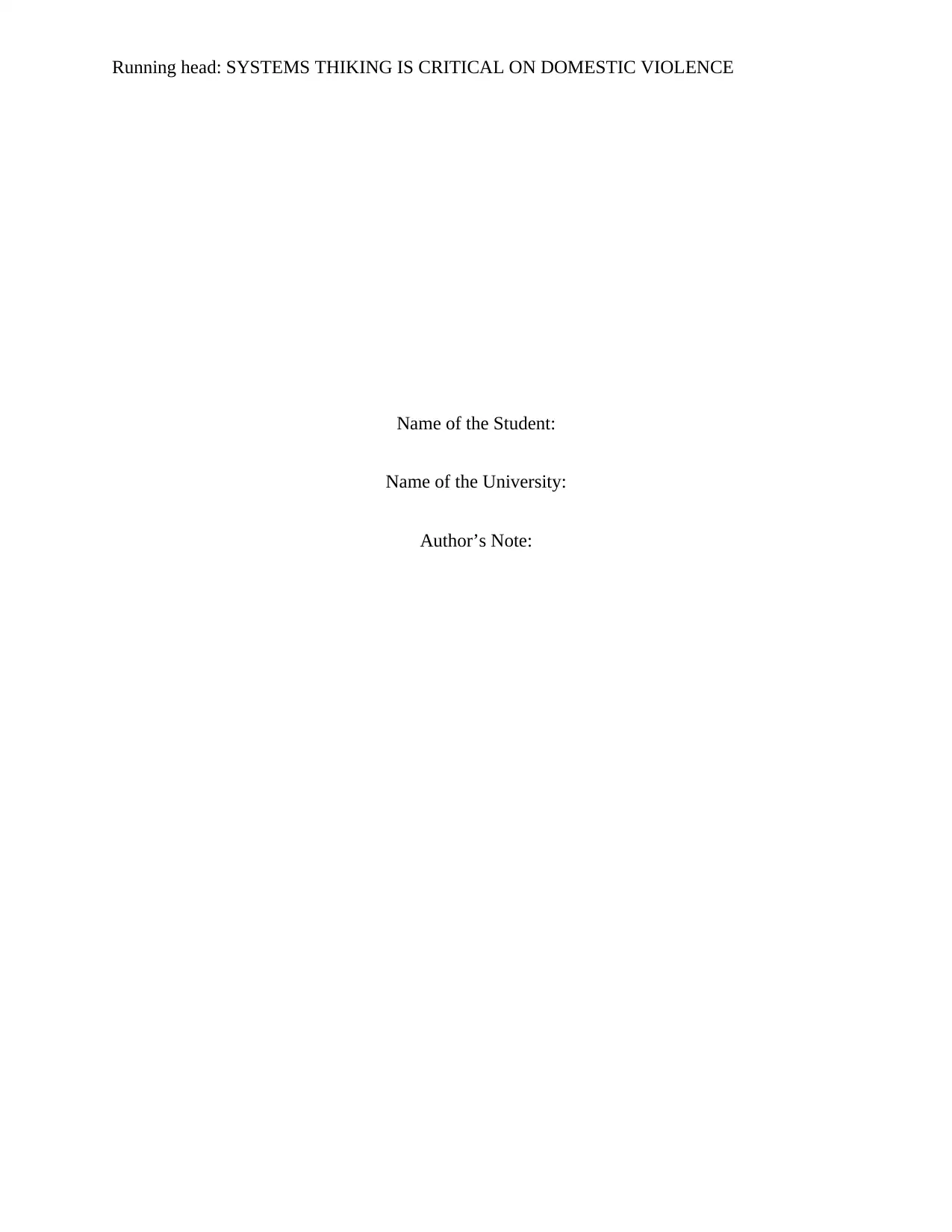
Running head: SYSTEMS THIKING IS CRITICAL ON DOMESTIC VIOLENCE
Name of the Student:
Name of the University:
Author’s Note:
Name of the Student:
Name of the University:
Author’s Note:
Secure Best Marks with AI Grader
Need help grading? Try our AI Grader for instant feedback on your assignments.
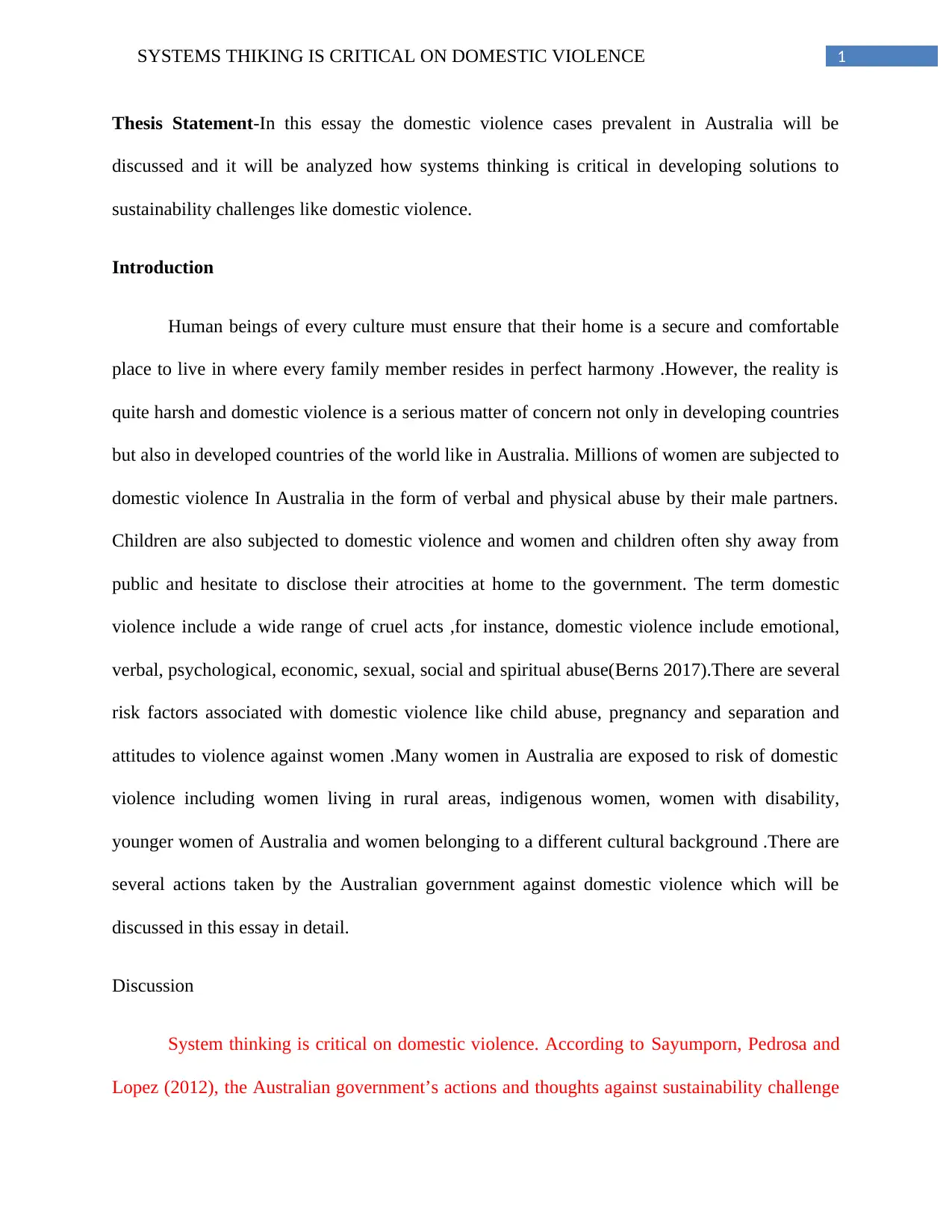
1SYSTEMS THIKING IS CRITICAL ON DOMESTIC VIOLENCE
Thesis Statement-In this essay the domestic violence cases prevalent in Australia will be
discussed and it will be analyzed how systems thinking is critical in developing solutions to
sustainability challenges like domestic violence.
Introduction
Human beings of every culture must ensure that their home is a secure and comfortable
place to live in where every family member resides in perfect harmony .However, the reality is
quite harsh and domestic violence is a serious matter of concern not only in developing countries
but also in developed countries of the world like in Australia. Millions of women are subjected to
domestic violence In Australia in the form of verbal and physical abuse by their male partners.
Children are also subjected to domestic violence and women and children often shy away from
public and hesitate to disclose their atrocities at home to the government. The term domestic
violence include a wide range of cruel acts ,for instance, domestic violence include emotional,
verbal, psychological, economic, sexual, social and spiritual abuse(Berns 2017).There are several
risk factors associated with domestic violence like child abuse, pregnancy and separation and
attitudes to violence against women .Many women in Australia are exposed to risk of domestic
violence including women living in rural areas, indigenous women, women with disability,
younger women of Australia and women belonging to a different cultural background .There are
several actions taken by the Australian government against domestic violence which will be
discussed in this essay in detail.
Discussion
System thinking is critical on domestic violence. According to Sayumporn, Pedrosa and
Lopez (2012), the Australian government’s actions and thoughts against sustainability challenge
Thesis Statement-In this essay the domestic violence cases prevalent in Australia will be
discussed and it will be analyzed how systems thinking is critical in developing solutions to
sustainability challenges like domestic violence.
Introduction
Human beings of every culture must ensure that their home is a secure and comfortable
place to live in where every family member resides in perfect harmony .However, the reality is
quite harsh and domestic violence is a serious matter of concern not only in developing countries
but also in developed countries of the world like in Australia. Millions of women are subjected to
domestic violence In Australia in the form of verbal and physical abuse by their male partners.
Children are also subjected to domestic violence and women and children often shy away from
public and hesitate to disclose their atrocities at home to the government. The term domestic
violence include a wide range of cruel acts ,for instance, domestic violence include emotional,
verbal, psychological, economic, sexual, social and spiritual abuse(Berns 2017).There are several
risk factors associated with domestic violence like child abuse, pregnancy and separation and
attitudes to violence against women .Many women in Australia are exposed to risk of domestic
violence including women living in rural areas, indigenous women, women with disability,
younger women of Australia and women belonging to a different cultural background .There are
several actions taken by the Australian government against domestic violence which will be
discussed in this essay in detail.
Discussion
System thinking is critical on domestic violence. According to Sayumporn, Pedrosa and
Lopez (2012), the Australian government’s actions and thoughts against sustainability challenge
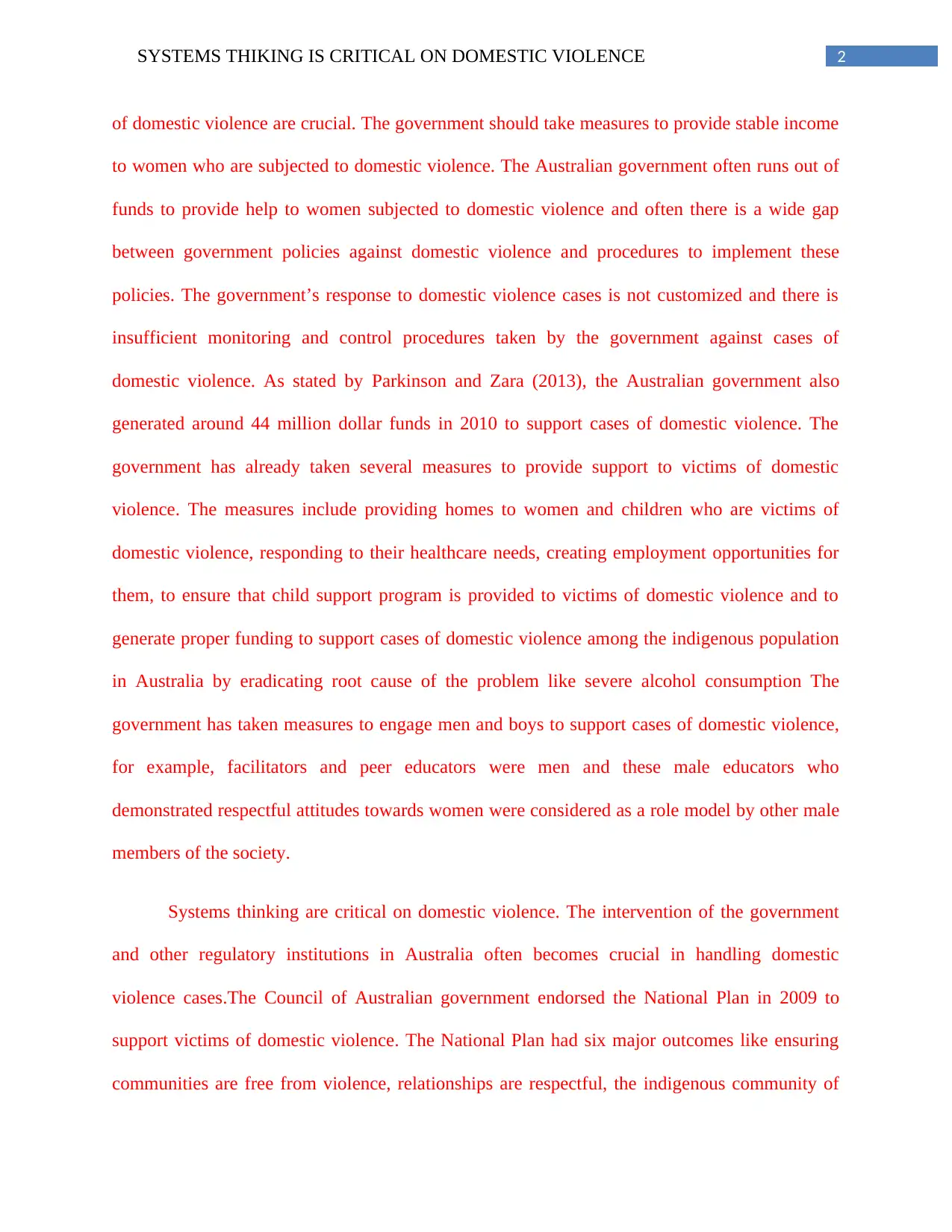
2SYSTEMS THIKING IS CRITICAL ON DOMESTIC VIOLENCE
of domestic violence are crucial. The government should take measures to provide stable income
to women who are subjected to domestic violence. The Australian government often runs out of
funds to provide help to women subjected to domestic violence and often there is a wide gap
between government policies against domestic violence and procedures to implement these
policies. The government’s response to domestic violence cases is not customized and there is
insufficient monitoring and control procedures taken by the government against cases of
domestic violence. As stated by Parkinson and Zara (2013), the Australian government also
generated around 44 million dollar funds in 2010 to support cases of domestic violence. The
government has already taken several measures to provide support to victims of domestic
violence. The measures include providing homes to women and children who are victims of
domestic violence, responding to their healthcare needs, creating employment opportunities for
them, to ensure that child support program is provided to victims of domestic violence and to
generate proper funding to support cases of domestic violence among the indigenous population
in Australia by eradicating root cause of the problem like severe alcohol consumption The
government has taken measures to engage men and boys to support cases of domestic violence,
for example, facilitators and peer educators were men and these male educators who
demonstrated respectful attitudes towards women were considered as a role model by other male
members of the society.
Systems thinking are critical on domestic violence. The intervention of the government
and other regulatory institutions in Australia often becomes crucial in handling domestic
violence cases.The Council of Australian government endorsed the National Plan in 2009 to
support victims of domestic violence. The National Plan had six major outcomes like ensuring
communities are free from violence, relationships are respectful, the indigenous community of
of domestic violence are crucial. The government should take measures to provide stable income
to women who are subjected to domestic violence. The Australian government often runs out of
funds to provide help to women subjected to domestic violence and often there is a wide gap
between government policies against domestic violence and procedures to implement these
policies. The government’s response to domestic violence cases is not customized and there is
insufficient monitoring and control procedures taken by the government against cases of
domestic violence. As stated by Parkinson and Zara (2013), the Australian government also
generated around 44 million dollar funds in 2010 to support cases of domestic violence. The
government has already taken several measures to provide support to victims of domestic
violence. The measures include providing homes to women and children who are victims of
domestic violence, responding to their healthcare needs, creating employment opportunities for
them, to ensure that child support program is provided to victims of domestic violence and to
generate proper funding to support cases of domestic violence among the indigenous population
in Australia by eradicating root cause of the problem like severe alcohol consumption The
government has taken measures to engage men and boys to support cases of domestic violence,
for example, facilitators and peer educators were men and these male educators who
demonstrated respectful attitudes towards women were considered as a role model by other male
members of the society.
Systems thinking are critical on domestic violence. The intervention of the government
and other regulatory institutions in Australia often becomes crucial in handling domestic
violence cases.The Council of Australian government endorsed the National Plan in 2009 to
support victims of domestic violence. The National Plan had six major outcomes like ensuring
communities are free from violence, relationships are respectful, the indigenous community of
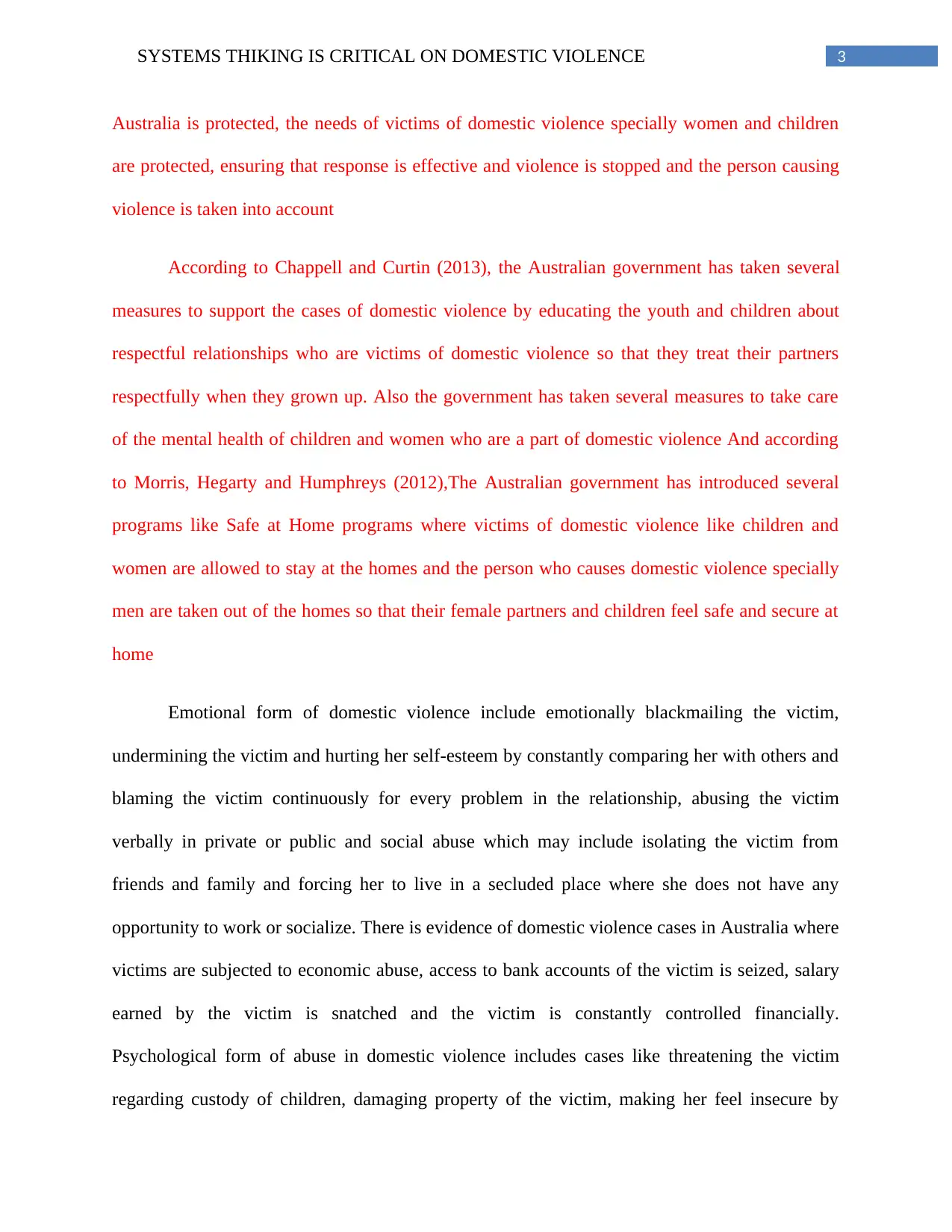
3SYSTEMS THIKING IS CRITICAL ON DOMESTIC VIOLENCE
Australia is protected, the needs of victims of domestic violence specially women and children
are protected, ensuring that response is effective and violence is stopped and the person causing
violence is taken into account
According to Chappell and Curtin (2013), the Australian government has taken several
measures to support the cases of domestic violence by educating the youth and children about
respectful relationships who are victims of domestic violence so that they treat their partners
respectfully when they grown up. Also the government has taken several measures to take care
of the mental health of children and women who are a part of domestic violence And according
to Morris, Hegarty and Humphreys (2012),The Australian government has introduced several
programs like Safe at Home programs where victims of domestic violence like children and
women are allowed to stay at the homes and the person who causes domestic violence specially
men are taken out of the homes so that their female partners and children feel safe and secure at
home
Emotional form of domestic violence include emotionally blackmailing the victim,
undermining the victim and hurting her self-esteem by constantly comparing her with others and
blaming the victim continuously for every problem in the relationship, abusing the victim
verbally in private or public and social abuse which may include isolating the victim from
friends and family and forcing her to live in a secluded place where she does not have any
opportunity to work or socialize. There is evidence of domestic violence cases in Australia where
victims are subjected to economic abuse, access to bank accounts of the victim is seized, salary
earned by the victim is snatched and the victim is constantly controlled financially.
Psychological form of abuse in domestic violence includes cases like threatening the victim
regarding custody of children, damaging property of the victim, making her feel insecure by
Australia is protected, the needs of victims of domestic violence specially women and children
are protected, ensuring that response is effective and violence is stopped and the person causing
violence is taken into account
According to Chappell and Curtin (2013), the Australian government has taken several
measures to support the cases of domestic violence by educating the youth and children about
respectful relationships who are victims of domestic violence so that they treat their partners
respectfully when they grown up. Also the government has taken several measures to take care
of the mental health of children and women who are a part of domestic violence And according
to Morris, Hegarty and Humphreys (2012),The Australian government has introduced several
programs like Safe at Home programs where victims of domestic violence like children and
women are allowed to stay at the homes and the person who causes domestic violence specially
men are taken out of the homes so that their female partners and children feel safe and secure at
home
Emotional form of domestic violence include emotionally blackmailing the victim,
undermining the victim and hurting her self-esteem by constantly comparing her with others and
blaming the victim continuously for every problem in the relationship, abusing the victim
verbally in private or public and social abuse which may include isolating the victim from
friends and family and forcing her to live in a secluded place where she does not have any
opportunity to work or socialize. There is evidence of domestic violence cases in Australia where
victims are subjected to economic abuse, access to bank accounts of the victim is seized, salary
earned by the victim is snatched and the victim is constantly controlled financially.
Psychological form of abuse in domestic violence includes cases like threatening the victim
regarding custody of children, damaging property of the victim, making her feel insecure by
Secure Best Marks with AI Grader
Need help grading? Try our AI Grader for instant feedback on your assignments.
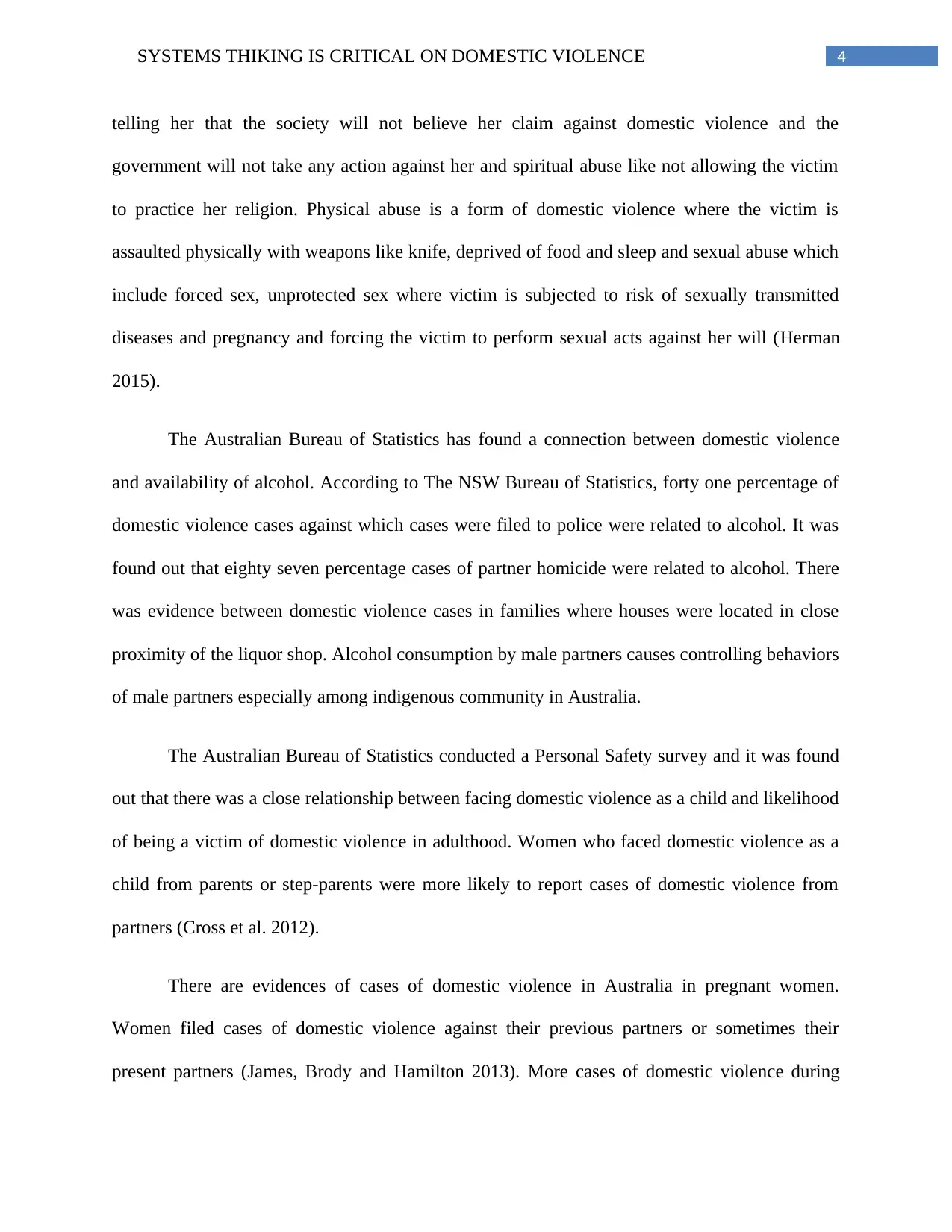
4SYSTEMS THIKING IS CRITICAL ON DOMESTIC VIOLENCE
telling her that the society will not believe her claim against domestic violence and the
government will not take any action against her and spiritual abuse like not allowing the victim
to practice her religion. Physical abuse is a form of domestic violence where the victim is
assaulted physically with weapons like knife, deprived of food and sleep and sexual abuse which
include forced sex, unprotected sex where victim is subjected to risk of sexually transmitted
diseases and pregnancy and forcing the victim to perform sexual acts against her will (Herman
2015).
The Australian Bureau of Statistics has found a connection between domestic violence
and availability of alcohol. According to The NSW Bureau of Statistics, forty one percentage of
domestic violence cases against which cases were filed to police were related to alcohol. It was
found out that eighty seven percentage cases of partner homicide were related to alcohol. There
was evidence between domestic violence cases in families where houses were located in close
proximity of the liquor shop. Alcohol consumption by male partners causes controlling behaviors
of male partners especially among indigenous community in Australia.
The Australian Bureau of Statistics conducted a Personal Safety survey and it was found
out that there was a close relationship between facing domestic violence as a child and likelihood
of being a victim of domestic violence in adulthood. Women who faced domestic violence as a
child from parents or step-parents were more likely to report cases of domestic violence from
partners (Cross et al. 2012).
There are evidences of cases of domestic violence in Australia in pregnant women.
Women filed cases of domestic violence against their previous partners or sometimes their
present partners (James, Brody and Hamilton 2013). More cases of domestic violence during
telling her that the society will not believe her claim against domestic violence and the
government will not take any action against her and spiritual abuse like not allowing the victim
to practice her religion. Physical abuse is a form of domestic violence where the victim is
assaulted physically with weapons like knife, deprived of food and sleep and sexual abuse which
include forced sex, unprotected sex where victim is subjected to risk of sexually transmitted
diseases and pregnancy and forcing the victim to perform sexual acts against her will (Herman
2015).
The Australian Bureau of Statistics has found a connection between domestic violence
and availability of alcohol. According to The NSW Bureau of Statistics, forty one percentage of
domestic violence cases against which cases were filed to police were related to alcohol. It was
found out that eighty seven percentage cases of partner homicide were related to alcohol. There
was evidence between domestic violence cases in families where houses were located in close
proximity of the liquor shop. Alcohol consumption by male partners causes controlling behaviors
of male partners especially among indigenous community in Australia.
The Australian Bureau of Statistics conducted a Personal Safety survey and it was found
out that there was a close relationship between facing domestic violence as a child and likelihood
of being a victim of domestic violence in adulthood. Women who faced domestic violence as a
child from parents or step-parents were more likely to report cases of domestic violence from
partners (Cross et al. 2012).
There are evidences of cases of domestic violence in Australia in pregnant women.
Women filed cases of domestic violence against their previous partners or sometimes their
present partners (James, Brody and Hamilton 2013). More cases of domestic violence during
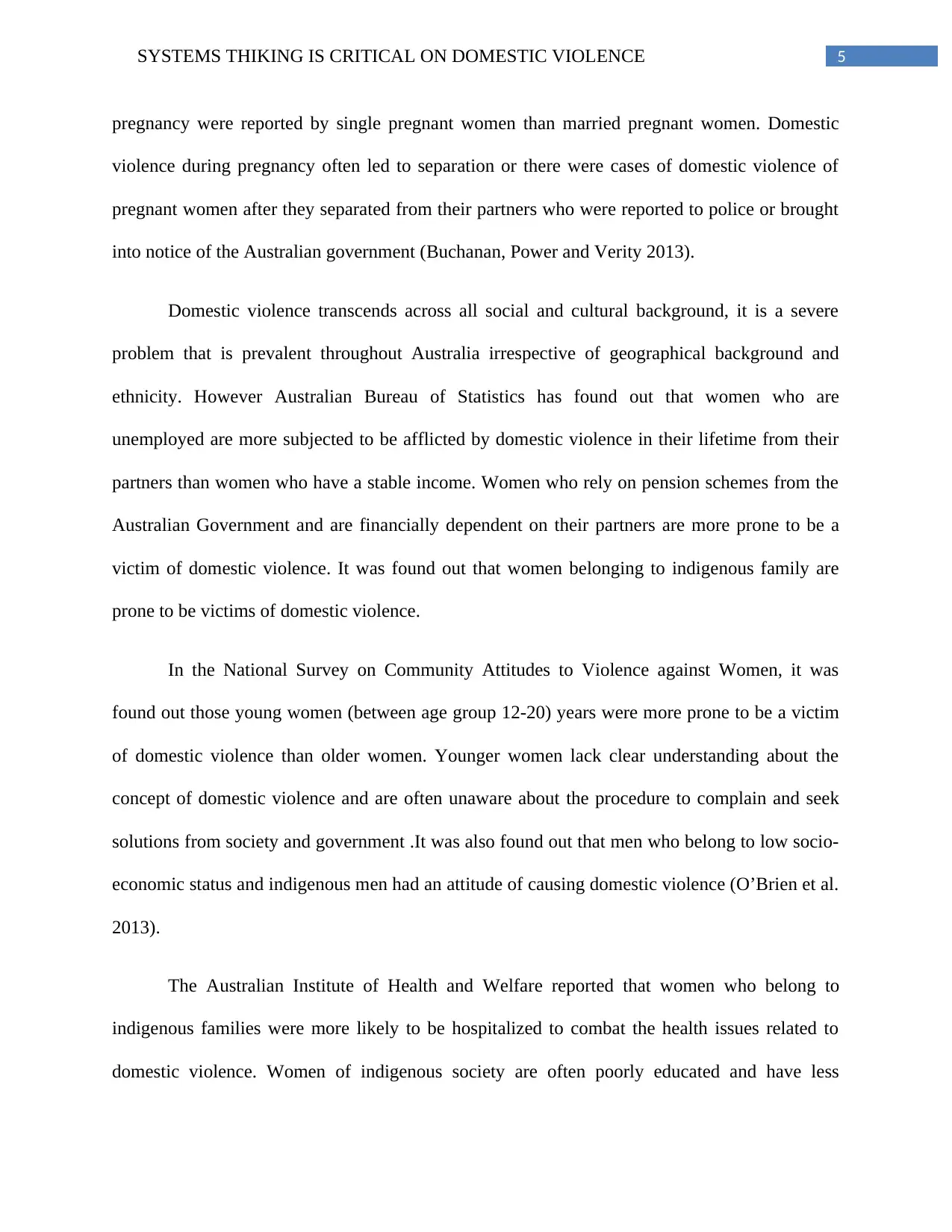
5SYSTEMS THIKING IS CRITICAL ON DOMESTIC VIOLENCE
pregnancy were reported by single pregnant women than married pregnant women. Domestic
violence during pregnancy often led to separation or there were cases of domestic violence of
pregnant women after they separated from their partners who were reported to police or brought
into notice of the Australian government (Buchanan, Power and Verity 2013).
Domestic violence transcends across all social and cultural background, it is a severe
problem that is prevalent throughout Australia irrespective of geographical background and
ethnicity. However Australian Bureau of Statistics has found out that women who are
unemployed are more subjected to be afflicted by domestic violence in their lifetime from their
partners than women who have a stable income. Women who rely on pension schemes from the
Australian Government and are financially dependent on their partners are more prone to be a
victim of domestic violence. It was found out that women belonging to indigenous family are
prone to be victims of domestic violence.
In the National Survey on Community Attitudes to Violence against Women, it was
found out those young women (between age group 12-20) years were more prone to be a victim
of domestic violence than older women. Younger women lack clear understanding about the
concept of domestic violence and are often unaware about the procedure to complain and seek
solutions from society and government .It was also found out that men who belong to low socio-
economic status and indigenous men had an attitude of causing domestic violence (O’Brien et al.
2013).
The Australian Institute of Health and Welfare reported that women who belong to
indigenous families were more likely to be hospitalized to combat the health issues related to
domestic violence. Women of indigenous society are often poorly educated and have less
pregnancy were reported by single pregnant women than married pregnant women. Domestic
violence during pregnancy often led to separation or there were cases of domestic violence of
pregnant women after they separated from their partners who were reported to police or brought
into notice of the Australian government (Buchanan, Power and Verity 2013).
Domestic violence transcends across all social and cultural background, it is a severe
problem that is prevalent throughout Australia irrespective of geographical background and
ethnicity. However Australian Bureau of Statistics has found out that women who are
unemployed are more subjected to be afflicted by domestic violence in their lifetime from their
partners than women who have a stable income. Women who rely on pension schemes from the
Australian Government and are financially dependent on their partners are more prone to be a
victim of domestic violence. It was found out that women belonging to indigenous family are
prone to be victims of domestic violence.
In the National Survey on Community Attitudes to Violence against Women, it was
found out those young women (between age group 12-20) years were more prone to be a victim
of domestic violence than older women. Younger women lack clear understanding about the
concept of domestic violence and are often unaware about the procedure to complain and seek
solutions from society and government .It was also found out that men who belong to low socio-
economic status and indigenous men had an attitude of causing domestic violence (O’Brien et al.
2013).
The Australian Institute of Health and Welfare reported that women who belong to
indigenous families were more likely to be hospitalized to combat the health issues related to
domestic violence. Women of indigenous society are often poorly educated and have less
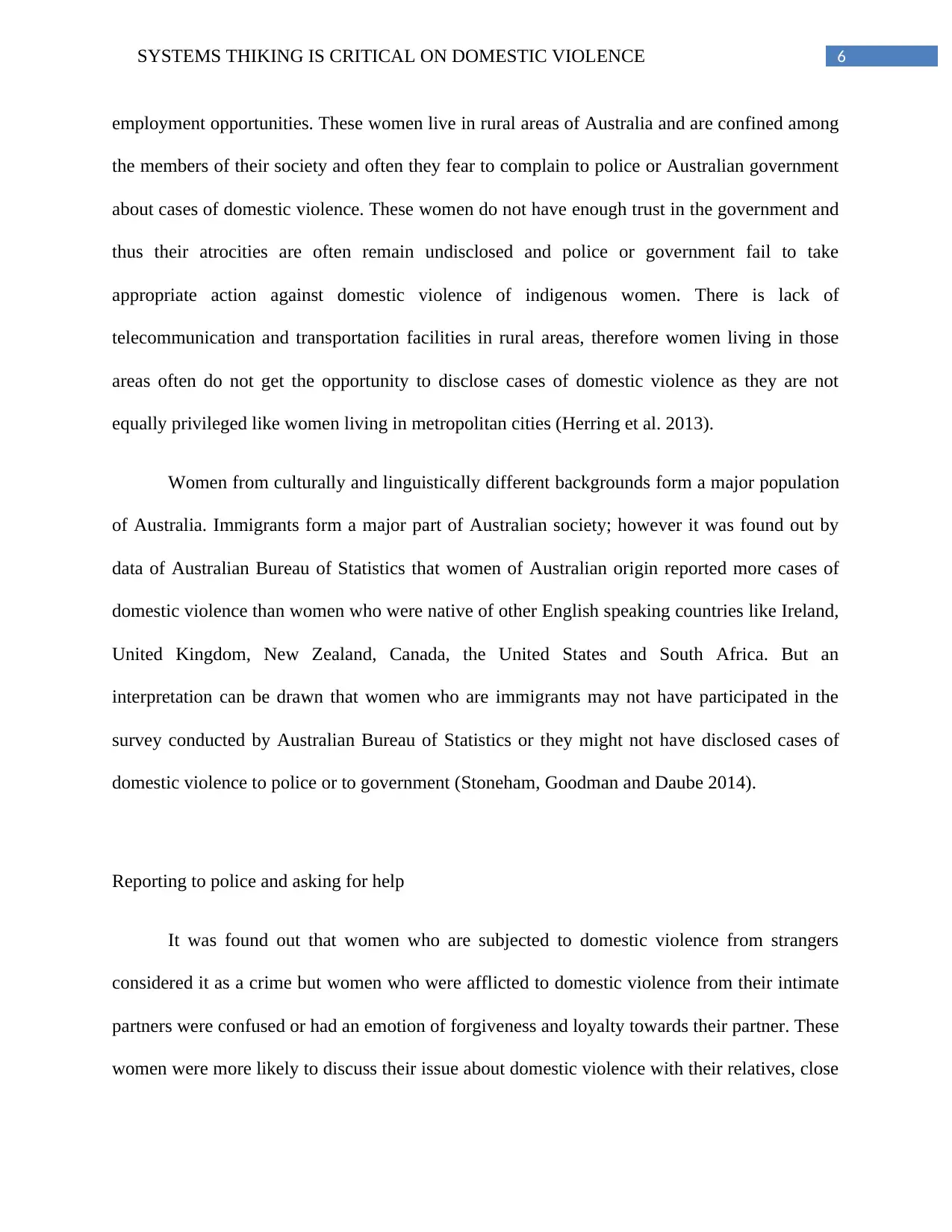
6SYSTEMS THIKING IS CRITICAL ON DOMESTIC VIOLENCE
employment opportunities. These women live in rural areas of Australia and are confined among
the members of their society and often they fear to complain to police or Australian government
about cases of domestic violence. These women do not have enough trust in the government and
thus their atrocities are often remain undisclosed and police or government fail to take
appropriate action against domestic violence of indigenous women. There is lack of
telecommunication and transportation facilities in rural areas, therefore women living in those
areas often do not get the opportunity to disclose cases of domestic violence as they are not
equally privileged like women living in metropolitan cities (Herring et al. 2013).
Women from culturally and linguistically different backgrounds form a major population
of Australia. Immigrants form a major part of Australian society; however it was found out by
data of Australian Bureau of Statistics that women of Australian origin reported more cases of
domestic violence than women who were native of other English speaking countries like Ireland,
United Kingdom, New Zealand, Canada, the United States and South Africa. But an
interpretation can be drawn that women who are immigrants may not have participated in the
survey conducted by Australian Bureau of Statistics or they might not have disclosed cases of
domestic violence to police or to government (Stoneham, Goodman and Daube 2014).
Reporting to police and asking for help
It was found out that women who are subjected to domestic violence from strangers
considered it as a crime but women who were afflicted to domestic violence from their intimate
partners were confused or had an emotion of forgiveness and loyalty towards their partner. These
women were more likely to discuss their issue about domestic violence with their relatives, close
employment opportunities. These women live in rural areas of Australia and are confined among
the members of their society and often they fear to complain to police or Australian government
about cases of domestic violence. These women do not have enough trust in the government and
thus their atrocities are often remain undisclosed and police or government fail to take
appropriate action against domestic violence of indigenous women. There is lack of
telecommunication and transportation facilities in rural areas, therefore women living in those
areas often do not get the opportunity to disclose cases of domestic violence as they are not
equally privileged like women living in metropolitan cities (Herring et al. 2013).
Women from culturally and linguistically different backgrounds form a major population
of Australia. Immigrants form a major part of Australian society; however it was found out by
data of Australian Bureau of Statistics that women of Australian origin reported more cases of
domestic violence than women who were native of other English speaking countries like Ireland,
United Kingdom, New Zealand, Canada, the United States and South Africa. But an
interpretation can be drawn that women who are immigrants may not have participated in the
survey conducted by Australian Bureau of Statistics or they might not have disclosed cases of
domestic violence to police or to government (Stoneham, Goodman and Daube 2014).
Reporting to police and asking for help
It was found out that women who are subjected to domestic violence from strangers
considered it as a crime but women who were afflicted to domestic violence from their intimate
partners were confused or had an emotion of forgiveness and loyalty towards their partner. These
women were more likely to discuss their issue about domestic violence with their relatives, close
Paraphrase This Document
Need a fresh take? Get an instant paraphrase of this document with our AI Paraphraser
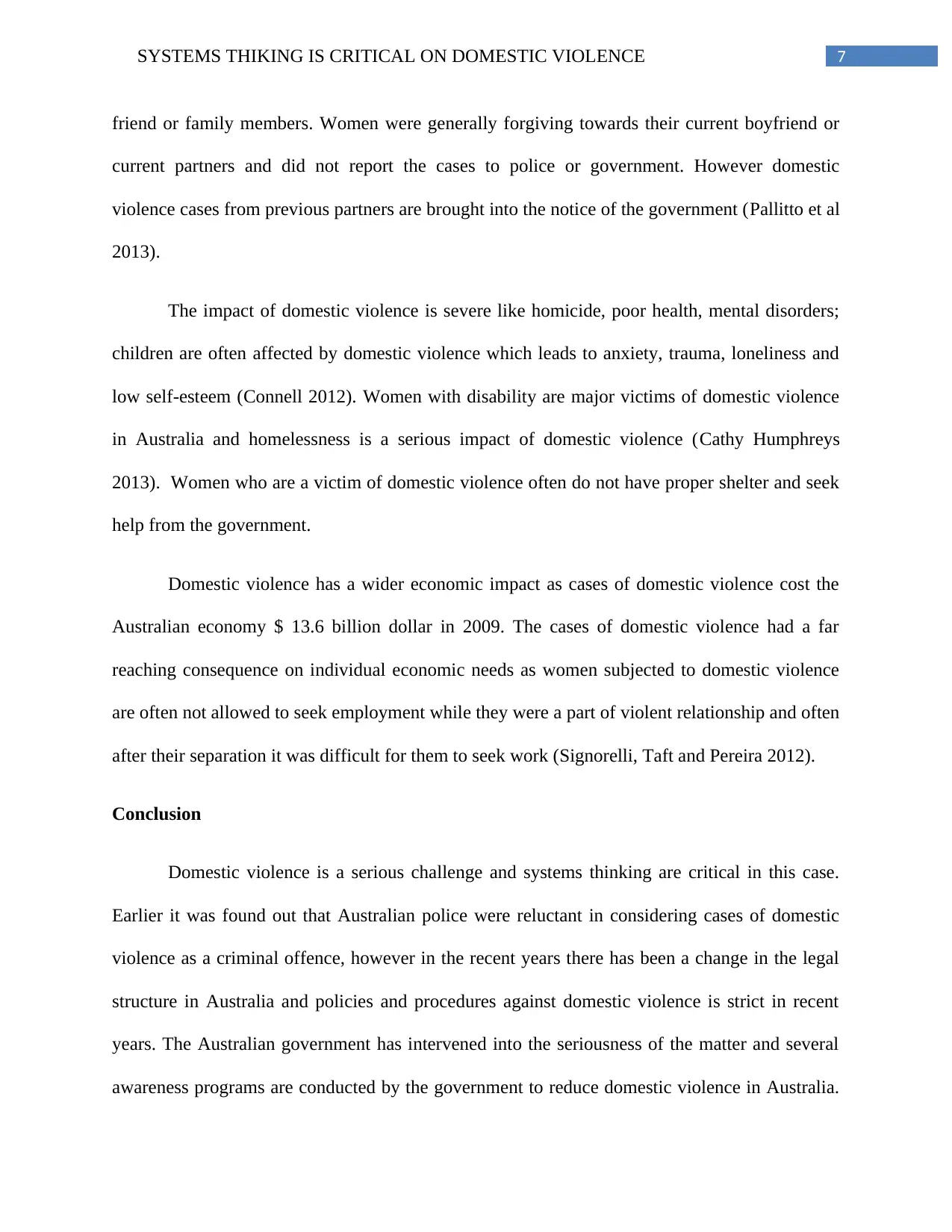
7SYSTEMS THIKING IS CRITICAL ON DOMESTIC VIOLENCE
friend or family members. Women were generally forgiving towards their current boyfriend or
current partners and did not report the cases to police or government. However domestic
violence cases from previous partners are brought into the notice of the government (Pallitto et al
2013).
The impact of domestic violence is severe like homicide, poor health, mental disorders;
children are often affected by domestic violence which leads to anxiety, trauma, loneliness and
low self-esteem (Connell 2012). Women with disability are major victims of domestic violence
in Australia and homelessness is a serious impact of domestic violence (Cathy Humphreys
2013). Women who are a victim of domestic violence often do not have proper shelter and seek
help from the government.
Domestic violence has a wider economic impact as cases of domestic violence cost the
Australian economy $ 13.6 billion dollar in 2009. The cases of domestic violence had a far
reaching consequence on individual economic needs as women subjected to domestic violence
are often not allowed to seek employment while they were a part of violent relationship and often
after their separation it was difficult for them to seek work (Signorelli, Taft and Pereira 2012).
Conclusion
Domestic violence is a serious challenge and systems thinking are critical in this case.
Earlier it was found out that Australian police were reluctant in considering cases of domestic
violence as a criminal offence, however in the recent years there has been a change in the legal
structure in Australia and policies and procedures against domestic violence is strict in recent
years. The Australian government has intervened into the seriousness of the matter and several
awareness programs are conducted by the government to reduce domestic violence in Australia.
friend or family members. Women were generally forgiving towards their current boyfriend or
current partners and did not report the cases to police or government. However domestic
violence cases from previous partners are brought into the notice of the government (Pallitto et al
2013).
The impact of domestic violence is severe like homicide, poor health, mental disorders;
children are often affected by domestic violence which leads to anxiety, trauma, loneliness and
low self-esteem (Connell 2012). Women with disability are major victims of domestic violence
in Australia and homelessness is a serious impact of domestic violence (Cathy Humphreys
2013). Women who are a victim of domestic violence often do not have proper shelter and seek
help from the government.
Domestic violence has a wider economic impact as cases of domestic violence cost the
Australian economy $ 13.6 billion dollar in 2009. The cases of domestic violence had a far
reaching consequence on individual economic needs as women subjected to domestic violence
are often not allowed to seek employment while they were a part of violent relationship and often
after their separation it was difficult for them to seek work (Signorelli, Taft and Pereira 2012).
Conclusion
Domestic violence is a serious challenge and systems thinking are critical in this case.
Earlier it was found out that Australian police were reluctant in considering cases of domestic
violence as a criminal offence, however in the recent years there has been a change in the legal
structure in Australia and policies and procedures against domestic violence is strict in recent
years. The Australian government has intervened into the seriousness of the matter and several
awareness programs are conducted by the government to reduce domestic violence in Australia.
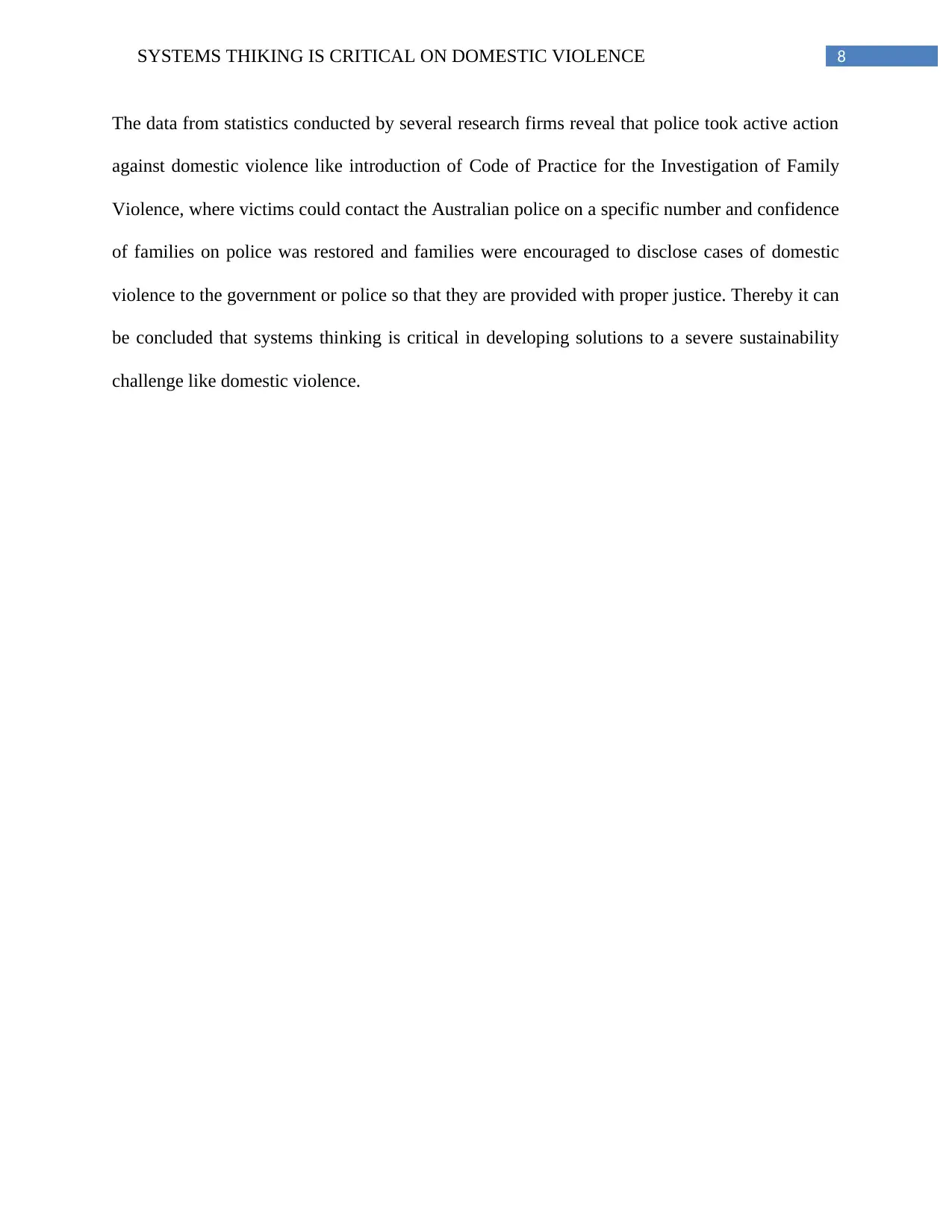
8SYSTEMS THIKING IS CRITICAL ON DOMESTIC VIOLENCE
The data from statistics conducted by several research firms reveal that police took active action
against domestic violence like introduction of Code of Practice for the Investigation of Family
Violence, where victims could contact the Australian police on a specific number and confidence
of families on police was restored and families were encouraged to disclose cases of domestic
violence to the government or police so that they are provided with proper justice. Thereby it can
be concluded that systems thinking is critical in developing solutions to a severe sustainability
challenge like domestic violence.
The data from statistics conducted by several research firms reveal that police took active action
against domestic violence like introduction of Code of Practice for the Investigation of Family
Violence, where victims could contact the Australian police on a specific number and confidence
of families on police was restored and families were encouraged to disclose cases of domestic
violence to the government or police so that they are provided with proper justice. Thereby it can
be concluded that systems thinking is critical in developing solutions to a severe sustainability
challenge like domestic violence.
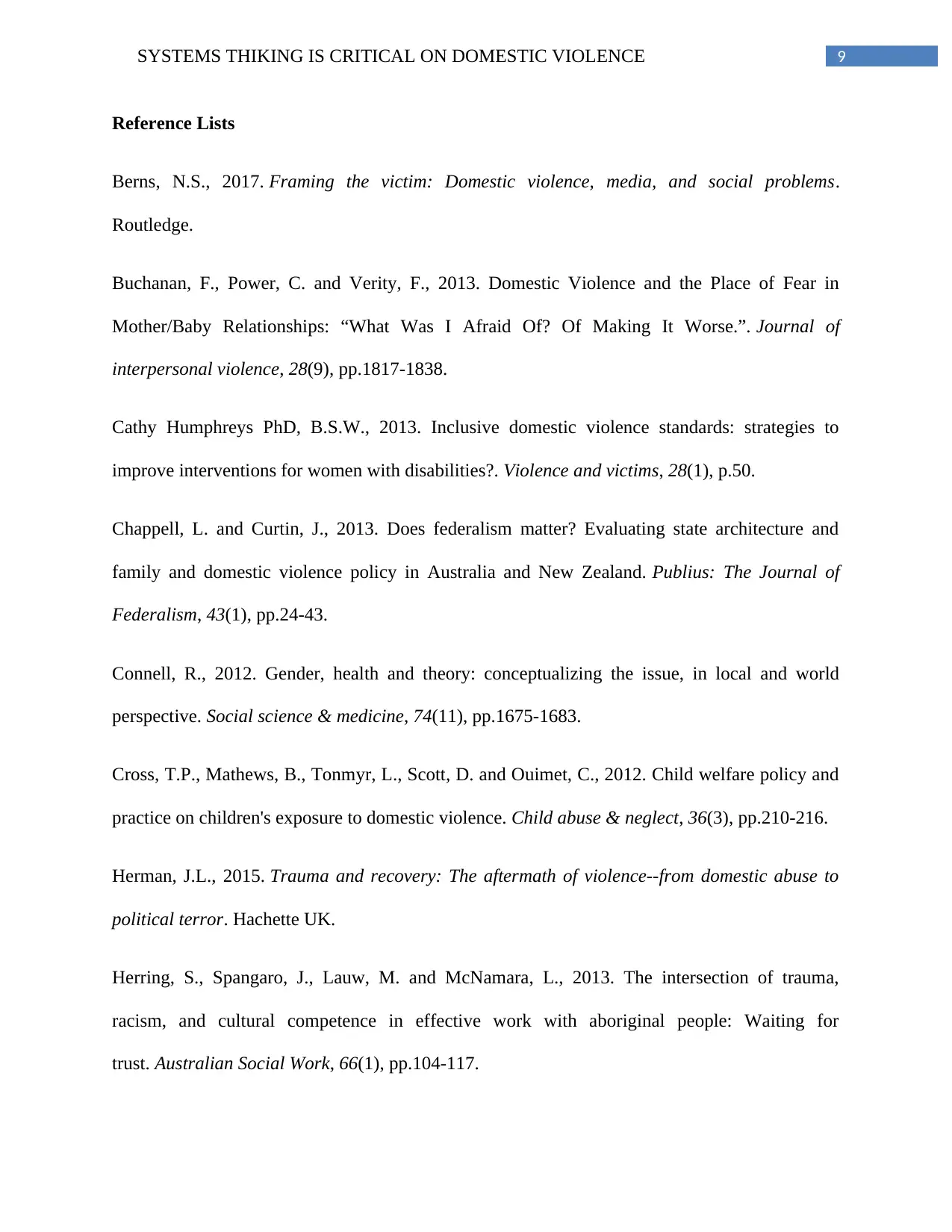
9SYSTEMS THIKING IS CRITICAL ON DOMESTIC VIOLENCE
Reference Lists
Berns, N.S., 2017. Framing the victim: Domestic violence, media, and social problems.
Routledge.
Buchanan, F., Power, C. and Verity, F., 2013. Domestic Violence and the Place of Fear in
Mother/Baby Relationships: “What Was I Afraid Of? Of Making It Worse.”. Journal of
interpersonal violence, 28(9), pp.1817-1838.
Cathy Humphreys PhD, B.S.W., 2013. Inclusive domestic violence standards: strategies to
improve interventions for women with disabilities?. Violence and victims, 28(1), p.50.
Chappell, L. and Curtin, J., 2013. Does federalism matter? Evaluating state architecture and
family and domestic violence policy in Australia and New Zealand. Publius: The Journal of
Federalism, 43(1), pp.24-43.
Connell, R., 2012. Gender, health and theory: conceptualizing the issue, in local and world
perspective. Social science & medicine, 74(11), pp.1675-1683.
Cross, T.P., Mathews, B., Tonmyr, L., Scott, D. and Ouimet, C., 2012. Child welfare policy and
practice on children's exposure to domestic violence. Child abuse & neglect, 36(3), pp.210-216.
Herman, J.L., 2015. Trauma and recovery: The aftermath of violence--from domestic abuse to
political terror. Hachette UK.
Herring, S., Spangaro, J., Lauw, M. and McNamara, L., 2013. The intersection of trauma,
racism, and cultural competence in effective work with aboriginal people: Waiting for
trust. Australian Social Work, 66(1), pp.104-117.
Reference Lists
Berns, N.S., 2017. Framing the victim: Domestic violence, media, and social problems.
Routledge.
Buchanan, F., Power, C. and Verity, F., 2013. Domestic Violence and the Place of Fear in
Mother/Baby Relationships: “What Was I Afraid Of? Of Making It Worse.”. Journal of
interpersonal violence, 28(9), pp.1817-1838.
Cathy Humphreys PhD, B.S.W., 2013. Inclusive domestic violence standards: strategies to
improve interventions for women with disabilities?. Violence and victims, 28(1), p.50.
Chappell, L. and Curtin, J., 2013. Does federalism matter? Evaluating state architecture and
family and domestic violence policy in Australia and New Zealand. Publius: The Journal of
Federalism, 43(1), pp.24-43.
Connell, R., 2012. Gender, health and theory: conceptualizing the issue, in local and world
perspective. Social science & medicine, 74(11), pp.1675-1683.
Cross, T.P., Mathews, B., Tonmyr, L., Scott, D. and Ouimet, C., 2012. Child welfare policy and
practice on children's exposure to domestic violence. Child abuse & neglect, 36(3), pp.210-216.
Herman, J.L., 2015. Trauma and recovery: The aftermath of violence--from domestic abuse to
political terror. Hachette UK.
Herring, S., Spangaro, J., Lauw, M. and McNamara, L., 2013. The intersection of trauma,
racism, and cultural competence in effective work with aboriginal people: Waiting for
trust. Australian Social Work, 66(1), pp.104-117.
Secure Best Marks with AI Grader
Need help grading? Try our AI Grader for instant feedback on your assignments.
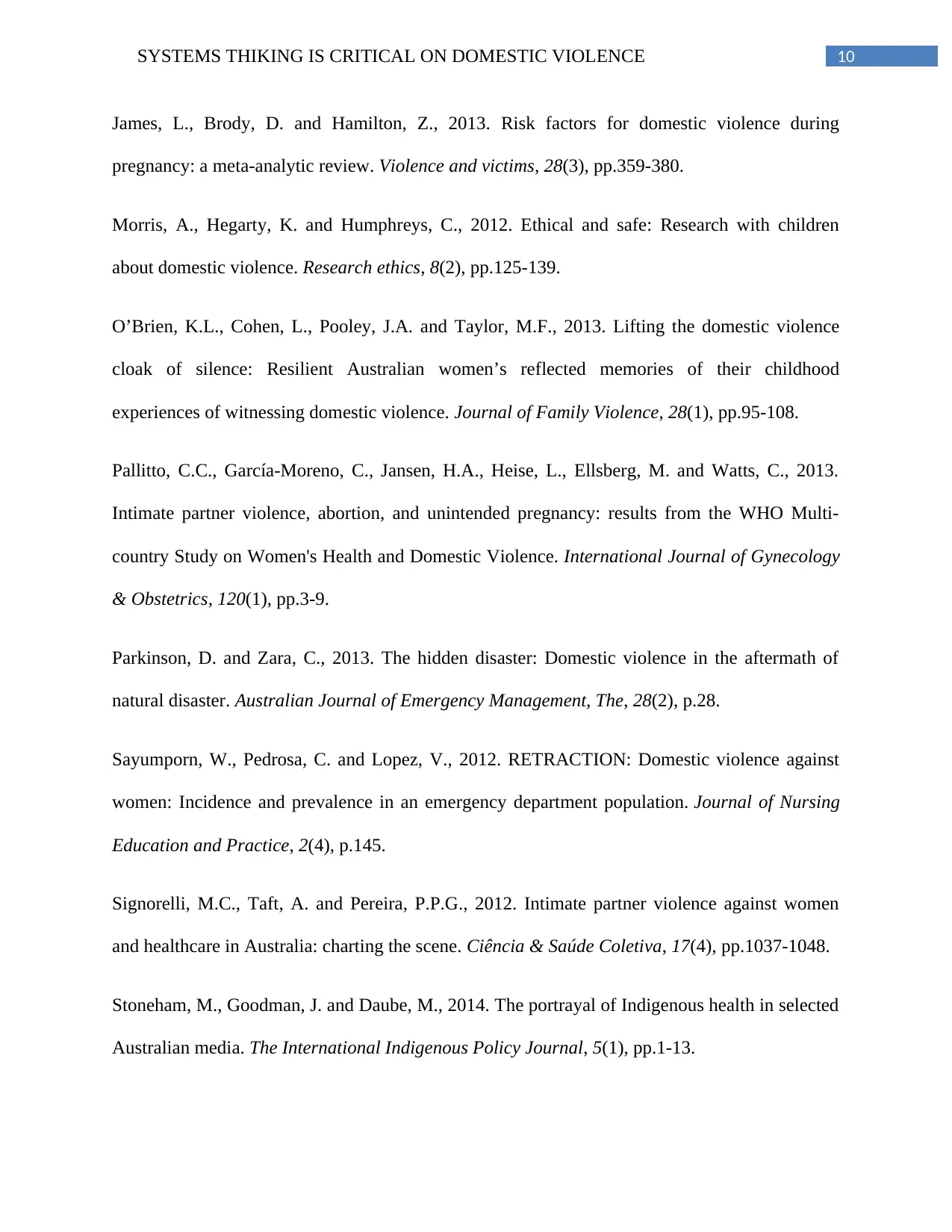
10SYSTEMS THIKING IS CRITICAL ON DOMESTIC VIOLENCE
James, L., Brody, D. and Hamilton, Z., 2013. Risk factors for domestic violence during
pregnancy: a meta-analytic review. Violence and victims, 28(3), pp.359-380.
Morris, A., Hegarty, K. and Humphreys, C., 2012. Ethical and safe: Research with children
about domestic violence. Research ethics, 8(2), pp.125-139.
O’Brien, K.L., Cohen, L., Pooley, J.A. and Taylor, M.F., 2013. Lifting the domestic violence
cloak of silence: Resilient Australian women’s reflected memories of their childhood
experiences of witnessing domestic violence. Journal of Family Violence, 28(1), pp.95-108.
Pallitto, C.C., García-Moreno, C., Jansen, H.A., Heise, L., Ellsberg, M. and Watts, C., 2013.
Intimate partner violence, abortion, and unintended pregnancy: results from the WHO Multi-
country Study on Women's Health and Domestic Violence. International Journal of Gynecology
& Obstetrics, 120(1), pp.3-9.
Parkinson, D. and Zara, C., 2013. The hidden disaster: Domestic violence in the aftermath of
natural disaster. Australian Journal of Emergency Management, The, 28(2), p.28.
Sayumporn, W., Pedrosa, C. and Lopez, V., 2012. RETRACTION: Domestic violence against
women: Incidence and prevalence in an emergency department population. Journal of Nursing
Education and Practice, 2(4), p.145.
Signorelli, M.C., Taft, A. and Pereira, P.P.G., 2012. Intimate partner violence against women
and healthcare in Australia: charting the scene. Ciência & Saúde Coletiva, 17(4), pp.1037-1048.
Stoneham, M., Goodman, J. and Daube, M., 2014. The portrayal of Indigenous health in selected
Australian media. The International Indigenous Policy Journal, 5(1), pp.1-13.
James, L., Brody, D. and Hamilton, Z., 2013. Risk factors for domestic violence during
pregnancy: a meta-analytic review. Violence and victims, 28(3), pp.359-380.
Morris, A., Hegarty, K. and Humphreys, C., 2012. Ethical and safe: Research with children
about domestic violence. Research ethics, 8(2), pp.125-139.
O’Brien, K.L., Cohen, L., Pooley, J.A. and Taylor, M.F., 2013. Lifting the domestic violence
cloak of silence: Resilient Australian women’s reflected memories of their childhood
experiences of witnessing domestic violence. Journal of Family Violence, 28(1), pp.95-108.
Pallitto, C.C., García-Moreno, C., Jansen, H.A., Heise, L., Ellsberg, M. and Watts, C., 2013.
Intimate partner violence, abortion, and unintended pregnancy: results from the WHO Multi-
country Study on Women's Health and Domestic Violence. International Journal of Gynecology
& Obstetrics, 120(1), pp.3-9.
Parkinson, D. and Zara, C., 2013. The hidden disaster: Domestic violence in the aftermath of
natural disaster. Australian Journal of Emergency Management, The, 28(2), p.28.
Sayumporn, W., Pedrosa, C. and Lopez, V., 2012. RETRACTION: Domestic violence against
women: Incidence and prevalence in an emergency department population. Journal of Nursing
Education and Practice, 2(4), p.145.
Signorelli, M.C., Taft, A. and Pereira, P.P.G., 2012. Intimate partner violence against women
and healthcare in Australia: charting the scene. Ciência & Saúde Coletiva, 17(4), pp.1037-1048.
Stoneham, M., Goodman, J. and Daube, M., 2014. The portrayal of Indigenous health in selected
Australian media. The International Indigenous Policy Journal, 5(1), pp.1-13.
1 out of 11
Related Documents
Your All-in-One AI-Powered Toolkit for Academic Success.
+13062052269
info@desklib.com
Available 24*7 on WhatsApp / Email
![[object Object]](/_next/static/media/star-bottom.7253800d.svg)
Unlock your academic potential
© 2024 | Zucol Services PVT LTD | All rights reserved.





